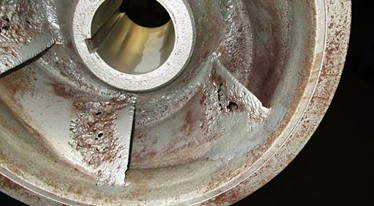Probleemstelling:
MYRRHA is a flexible fast-spectrum research reactor under design at SCK•CEN, the Belgian Nuclear Research Centre. The primary coolant is Lead Bismuth Eutectic (LBE). Research on cavitation erosion in liquid LBE is crucial to confirm the safety of MYRRHA. Cavitation is an important phenomenon of pumps hydrodynamics, which can significantly accelerate erosion of pump parts and lead to their rapid destruction.

Figure 1: Result of cavitation on a pump impeller.
Currently, there is a gap in knowledge of the characteristics of cavitation in liquid LBE, conditions and factors affecting its appearance such as:
- Temperature of LBE;
- Static pressure;
- Impurity content;
- Surface condition of a test sample.
The experimental data will characterize the cavitation depending on various factors. This data can be used as input in the design of the MYRRHA pumps.